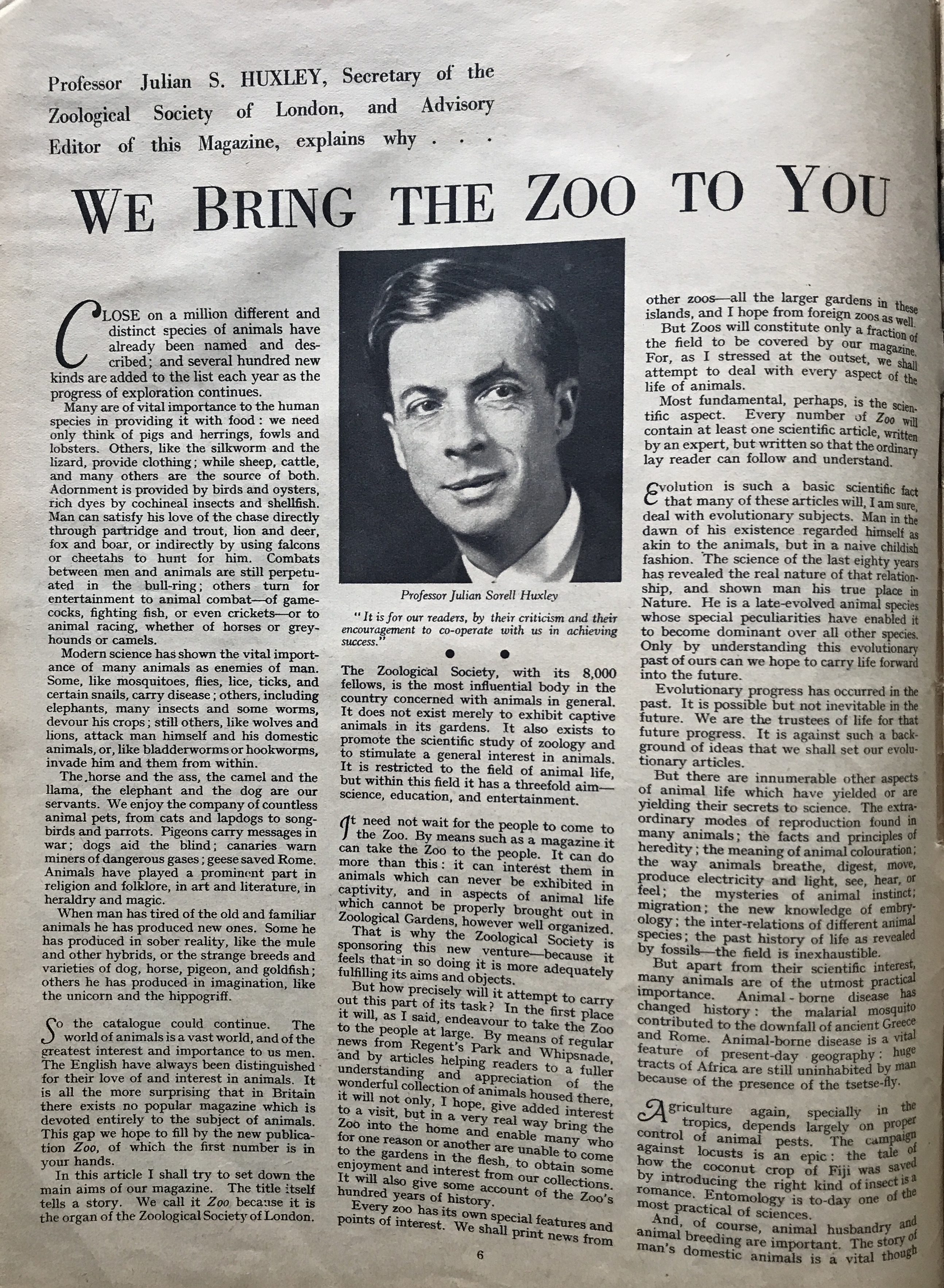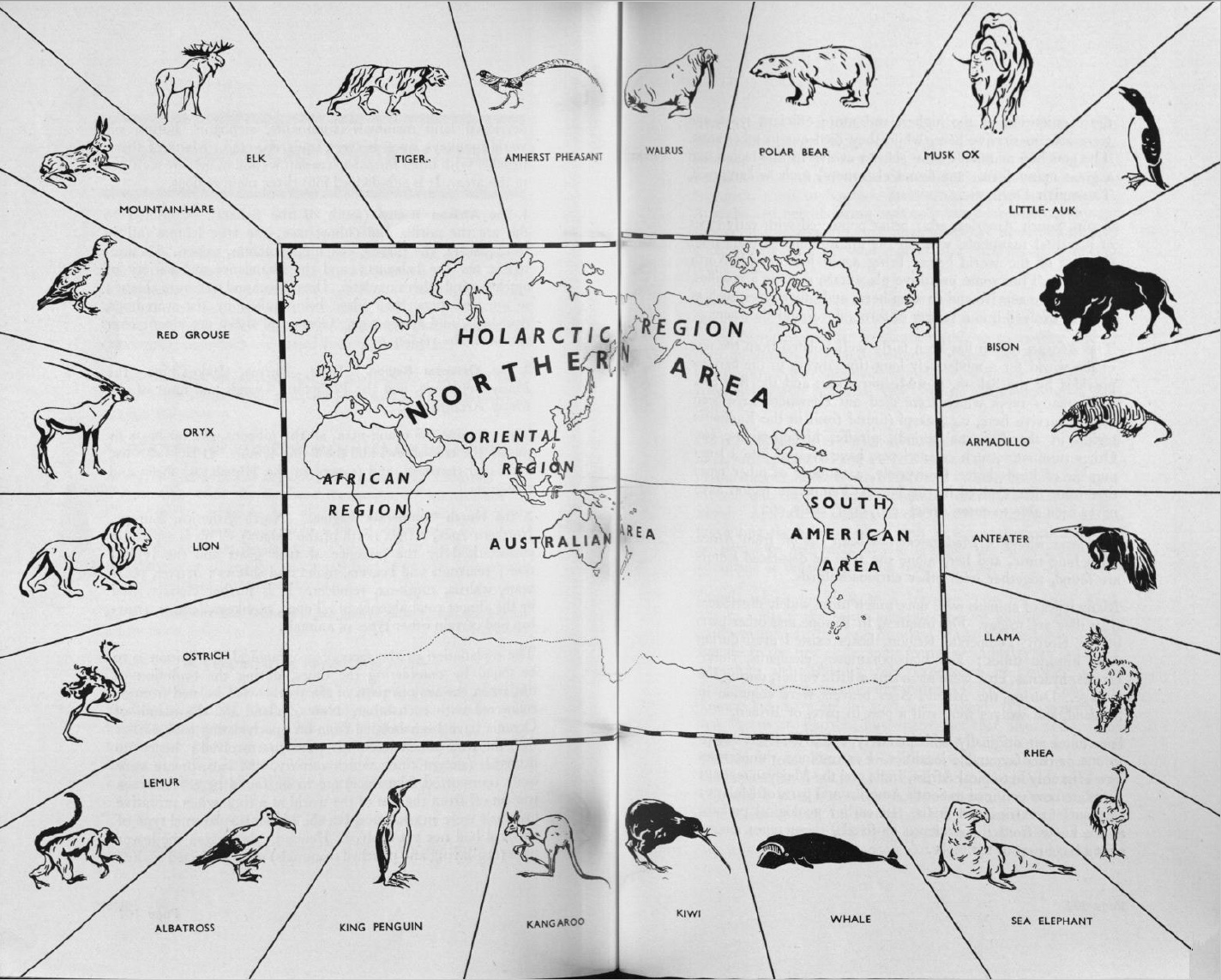Archive
Julian Huxley
- Julian
- Huxley
Sir Julian Sorell Huxley
- 22-06-1887
- London (GB)
- 14-02-1975
- London (GB)
- ZoologistPhilosopherWriter
Julian Huxley was the director of London Zoo from 1935 to 1942 and worked closely with emigrant photographers, artists and architects, including Berthold Lubetkin, Erna Pinner and Wolf Suschitzky.
Word Count: 27

Editorial by Julian Huxley in the first issue of Animal and Zoo Magazine, no. 1, 1936, p. 6 (METROMOD Archive). 
Charlotte Wolff. Studies in Hand-Reading. Chatto & Windus, 1936, p. 77: Reading Julian and Aldous Huxley’s hands (Deutsche Nationalbibliothek, Deutsches Exilarchiv 1933–1945, Frankfurt am Main). 
Charlotte Wolff. “The Form and Dermatoglyphs of the Hands and Feet of certain Anthropoid Apes”. Proceedings of the Zoological Society of London, Series A, 1937, Part 3, 347 + Plate (Library of the Zoological Institute, University of Hamburg). At the zoo’s behest, Charlotte Wolff applied chirology to the primates at London Zoo. 
Julian Huxley and Ludwig Koch. Animal Language. Photographs by Ylla. Country Life, 1938, cover (METROMOD Archive). Two records of animal voices were included with this sound book. 
Erna Pinner. “Map of geographical distribution.” Julian S. Huxley. Zoo. Official Guide to the Gardens and Aquarium of the Zoological Society of London, 1937, pp. 102–103 (ZSL Library, London, Original © Erna Pinner). 
Julian Huxley and Wolf Suschitzky. Kingdom of the Beasts. Thames & Hudson, 1956, pp. 157–158 (© The Estate of Wolfgang Suschitzky) 
László Moholy-Nagy, Bill of Fare, farewell dinner menu for Walter Gropius, London, March 1937: List of Toasts naming Julian Huxley as chairman of the event (Pritchard Papers, University of East Anglia, @ László Moholy-Nagy). “Young Artists in the Zoo” reads the headline to this photo essay on the Animal Art Studio at London Zoo, published in the Animal and Zoo Magazine, vol. 2, no. 11, 1938, p. 18–19 (METROMOD Archive). Allan, John. Berthold Lubetkin: Architecture and the Tradition of Progress. Artifice, 2012.
Baker, J. R. Julian Huxley. Homme de science et citoyen du monde 1887–1975. UNESCO, 1978.
Barrington-Johnson, J. The Zoo. The Story of London Zoo. Robert Hale, 2005.
Huxley, Julian. “Die Grundgedanken des evolutionären Humanismus.” Julian Huxley. Der evolutionäre Humanismus. Zehn Essays über die Leitgedanken und Probleme, Beck, 1964, pp. 13–70.
Huxley, Julian. Ein Leben für die Zukunft. Erinnerungen. Translated by Wilhelm Höck, Paul List Verlag, 1974.
Huxley, Julian, and Ludwig Koch. Animal Language. Photographs by Ylla. Country Life, 1938.
Kellaway, Kate. “How the Observer brought the WWF into being.” The Observer, 7 November 2010, www.theguardian.com/environment/2010/nov/07/wwf-world-wildlife-fund-huxley. Accessed 22 March 2021.
Kevles, Daniel J. “Huxley and the Popularization of Science.” Julian Huxley. Biologist and Statesman of Science, edited by C. Kenneth Waters and Albert Van Helden, Rice University Press, 1992, pp. 238–251.
Sommer, Marianne. “Animal Sounds against the Noise of Modernity and War: Julian Huxley (1887–1975) and the Preservation of the Sonic World Heritage.” 19 January 2017, Journal of Sonic Studies, vol. 13, no. 13, 2017, www.researchcatalogue.net/view/325229/325230. Accessed 3 April 2021.
Sommer, Marianne. “Tierstimmen gegen den Lärm von Krieg und Moderne. Julian Huxley und das akustische Erbe in Soundbook, Film und Comic.” Zwitschern, Bellen, Röhren. Tierlaute in der Wissens-, Medientechnik- und Musikgeschichte, edited by Marianne Sommer and Denise Reimann, Neofelis, 2018, pp. 113–143.
Suschitzky, Wolf and Julian Huxley. Kingdom of the Beasts. Thames and Hudson, 1956.
Waters, C. Kenneth. “Introduction: Revising Our Picture of Julian Huxley.” Julian Huxley. Biologist and Statesman of Science, edited by C. Kenneth Waters and Albert Van Helden, Rice University Press, 1992, pp. 1–27.
Wolff, Charlotte. “The Form and Dermatoglyphs of the Hands and Feet of certain Anthropoid Apes.” Proceedings of the Zoological Society of London, vol. 107, Series A, Part 3, September 1937, pp. 347–350. ZSL, doi: doi.org/10.1111/j.1096-3642.1937.tb00816.x. Accessed 3 April 2021.
Wolff, Charlotte. “A Comparative Study of the Form and Dermatoglyphs of the Extremities of Primates.” Proceedings of the Zoological Society of London, vol. 108, Series A, Part 1, April 1938, pp. 143–161. ZSL, doi: doi.org/10.1111/j.1469-7998.1938.tb00025.x. Accessed 7 March 2021.
Wolff, Charlotte. Augenblicke verändern uns mehr als die Zeit. Eine Autobiographie. Translated by Michaela Huber, Beltz Verlag, 1982.
Word Count: 349
Julian Sorell Huxley Papers, 1899–1980, Woodson Research Center, Fondren Library, Rice University.
Word Count: 11
London Zoo, Outer Circle, London NW1 (workplace and residence).
- London
- Burcu Dogramaci. "Julian Huxley." METROMOD Archive, 2021, https://archive.metromod.net/viewer.p/69/1470/object/5138-11259857, last modified: 12-05-2021.
-
László Moholy-NagyPhotographerGraphic DesignerPainterSculptorLondon
László Moholy-Nagy emigrated to London in 1935, where he worked in close contact with the local avantgarde and was commissioned for window display decoration, photo books, advertising and film work.
Word Count: 30
Wolf SuschitzkyPhotographerCinematographerLondonThe Viennese Wolf Suschitzky made a career as a photographer and cinematographer after emigrating to London in 1935.
Word Count: 17
Herbert ReadArt HistorianArt CriticPoetLondonThe British art historian Herbert Read established himself as a central figure in the London artistic scene in the 1930s and was one of the outstanding supporters of exiled artists.
Word Count: 30
Curious CreaturesBookLondonCurious Creatures by the émigré artist Erna Pinner was published in 1951 and explores unusual, overlooked and lesser-known curiosities of the animal world.
Word Count: 22
Animal LanguageSound BookLondonIn 1938, the London publisher Country Life published the Animal Language sound book which featured text by Julian Huxley, audio records produced by Ludwig Koch and photographs by Ylla.
Word Count: 28
Freie Deutsche KulturNewsletterLondonThe Free German League of Culture was an association of emigrant artists and authors who organised exhibitions, concerts and lectures. The events were announced in the Freie Deutsche Kultur newsletter.
Word Count: 30
Studies in Hand-ReadingBookLondonIn 1936, Charlotte Wolff’s Studies in Hand-Reading was published with analysis of the palms of Horst P. Horst, Aldous and Julian Huxley, Man Ray and Virginia Woolf, among others.
Word Count: 29
Visual Pleasures from Everyday ThingsBookletLondonVisual Pleasures from Everyday Things is a booklet written in 1946 by the emigrated architectural historian Nikolaus Pevsner with the aim of aesthetic education and teacher training.
Word Count: 26
Farewell Dinner for Walter GropiusDinnerLondonFriends and colleagues came together on 9 March 1937 to send off the architect Walter Gropius and his wife Ise Gropius, who had decided to leave for the United States.
Word Count: 28
Allies inside GermanyExhibitionLondonOn 3 July 1942, the Allies inside Germany exhibition, organised by the Free German League of Culture, opened in London in an empty shop at 149 Regent Street.
Word Count: 25
20th Century German ArtExhibitionLondonThe 20th Century German Art exhibition of 1938 gave visibility to artists who had been defamed at the Munich exhibition Entartete Kunst and were persecuted by the National Socialist regime.
Word Count: 29
Isokon CompanyArchitecture and Furniture CompanyLondonThe furniture design and architecture company Isokon was an important commissioner for emigrants such as Marcel Breuer, Walter Gropius, László Moholy-Nagy, Ernst Riess and Edith Tudor-Hart.
Word Count: 27
YllaPhotographerNew YorkYlla was an Austrian-born photographer who emigrated to New York in 1941. Specialising in animal photography, she produced not only studio photographs, but also shot outside on urban locations in the metropolis.
Word Count: 31
Thames & HudsonPublishing HouseLondonThe emigrants Eva Feuchtwang (later Eva Neurath) and Walter Neurath founded the Thames & Hudson publishing house in 1949, which published art history books, photo books and collection catalogues.
Word Count: 28